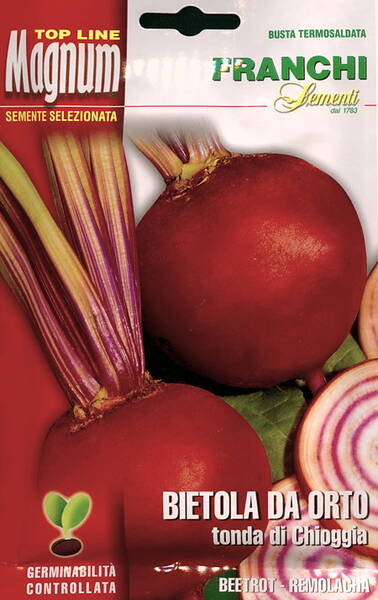Ex Tax: 2.04€
An early kind of beetroot. Vegetation period is approximately 60 days. Root vegetables of this beetroot variety, stands out for a sweet, mild flavor. The pulp is dark red with wide white rings.
Can be used fresh, canned, baked, and fried. Normally stored through the winter. The leaves of this variety of beetroot are also edible.
This variety grows best in medium weight, nicely and deeply-tilled, non-acid loam soil. If the soil is badly tilled, the beetroot sprouts in an uneven manner and thin.
1 g contains approximately 40-60 seeds.
* Harvesting and storage of beets.
More sugar accumulates in root vegetables during dry, sunny autumn, when the nights are cooler. Closer to harvesting, watering is stopped, which leads to an intense accumulation of sugar. But if the autumn is very dry, a week before harvesting, the plants need to be watered to avoid the root crops withering.
Cleaning is done in such a way as to prevent them from freezing. This is especially dangerous for varieties with cylindrical roots.
In the middle lane, beets begin to be harvested, depending on the weather, in the third decade of September and earlier. To improve storage conditions, it is recommended to roll beets in a cellar with sand, alternating layers of sand with root crops. The temperature should not drop below zero.
Important: when harvesting, do not cut the leaves too close to the root crop - leave three to six centimeters so that the juice does not leak out.
Signs of nitrogen starvation of plants are slow development, stunted growth, pale green leaves.
With a lack of phosphorus, growth stops and the formation of a root crop is delayed, the leaves become smaller.
A lack of potassium is indicated by a slowdown in growth, the appearance of spotty browning on the leaves, and dying off from the top and edges of plants.
With a lack of manganese, black spots are observed on the leaves (mistaken for a disease), then the leaf blade dies off and twists.
Lack of copper (on peat soils) causes root decay.
Boric acid reduces dry rot damage to root crops.
Top dressing with 1% sodium chloride solution increases the sugar content of root crops.
The first feeding is carried out when a pair of leaves appears with a mullein, diluted 4-5 times or 8-10 times with bird droppings.
The second - after 2-3 weeks with a solution of wood ash at the rate of 500 g per 10 liters of water.
Why aren't beets always sweet?
There may be several reasons:
Firstly, low-quality seeds.
Secondly, the wrong agricultural technique.
Beets are especially demanding on moisture at the beginning of the growing season and during the growth of root crops. Loves humus-rich soil, well loosened, so that there is sufficient air access to the root system. A timely breakthrough is necessary, since with thickened sowing, root crops are poorly tied.
Top dressing on the ridges is best done with mullein infusion, wood ash (3 glasses per 1 m2). Ash, in addition to nutrition, also reduces the acidity of the soil, which harms the beets.
Roots grown in dry, hard soil take on a bitter taste. And, here, ordinary table salt increases the sugar content of beets. Therefore, we recommend trying the dressing prepared according to this recipe:
1 teaspoon of salt in a bucket of water (this is the norm for 1 m2).












